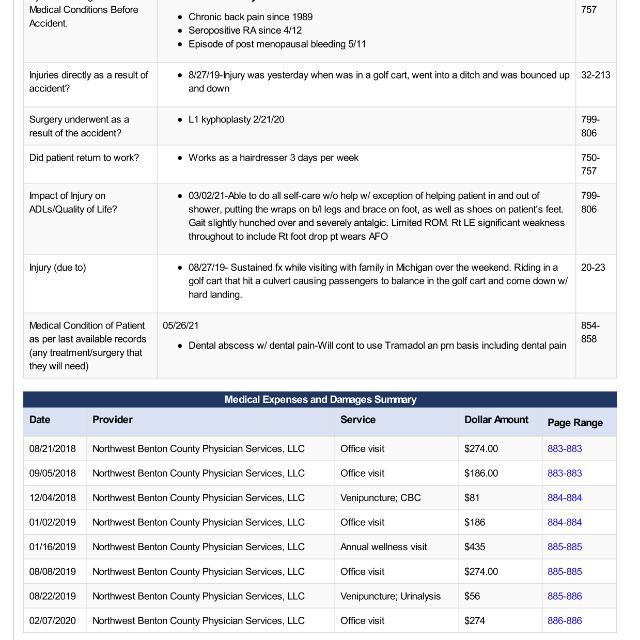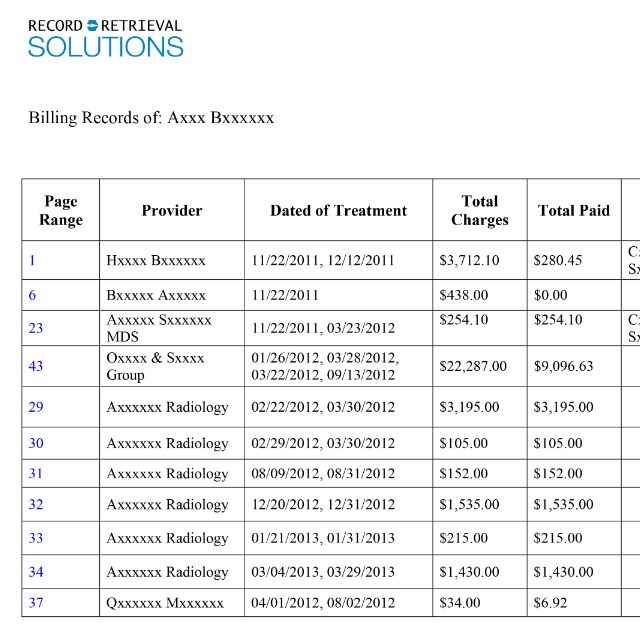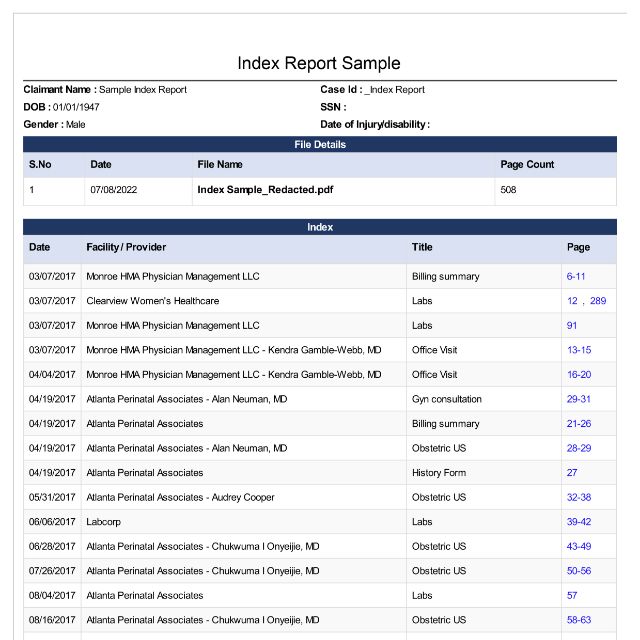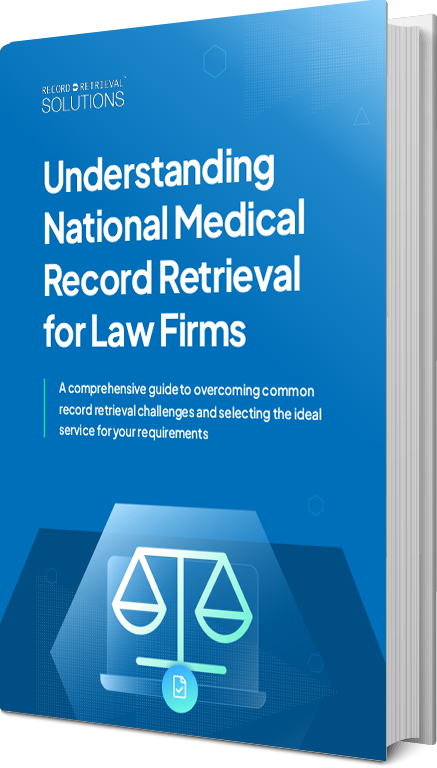If you’re working with medical records for legal or healthcare purposes, understanding how to interpret, organize, and present them clearly is essential. That’s where medical summaries and medical chronologies come in. These tools help you quickly grasp a patient’s history, identify key medical events, and support accurate decision-making.
Let’s break down what these terms mean, how they’re used, and how you can benefit from medical record summary services in the U.S.
Table of Contents
What Is a Medical Summary?
A medical summary is a condensed version of a patient’s full health history. It includes major diagnoses, treatments, surgeries, medications, and outcomes, all presented in a clear and concise format. In short, it answers the question: “What is the medical history of this patient?”
Medical summaries are particularly useful when you’re:
Preparing for legal cases
Managing insurance claims
Coordinating care across multiple providers
Reviewing large volumes of medical documents
These summaries highlight important details found in medical documents examples such as surgical reports, discharge summaries, and lab test results—which are usually organized in a structured way within the medical chart.
Example Use Case:
If you’re a personal injury attorney, a medical summary for law firms can help you focus on treatment milestones and causation links without combing through hundreds of pages.
Need a quick, clear patient summary?
Importance of medical summaries and chronologies for doctors and lawyers.
The importance of medical summaries and chronologies for doctors and lawyers cannot be overstated. These tools streamline the analysis of complex medical information, enhance collaboration and decision-making, and ultimately contribute to better patient care and stronger legal outcomes. Whether in the realm of medicine or law, harnessing the power of these documents unlocks crucial insights that drive success and ensure the best possible outcomes for both professionals and their clients.
What are the Benefits of Medical Summaries
For doctors, medical summaries provide a comprehensive overview of a patient’s medical history, treatments, and diagnoses. They condense extensive medical records into a concise format, allowing physicians to quickly grasp the essential details necessary for informed decision-making. With these summaries, doctors can efficiently assess a patient’s condition, track treatment progress, and collaborate with colleagues, ultimately enhancing the quality of care provided. Likewise, lawyers rely on medical summaries and chronologies to navigate the intricate world of medical information in legal cases. Whether it’s personal injury claims, medical malpractice suits, or disability cases, these documents serve as a roadmap, guiding legal professionals through the complex web of medical jargon and intricacies. Medical summaries provide lawyers with a comprehensive understanding of a client’s medical history, ensuring they can build strong arguments, present compelling evidence, and effectively advocate for their clients’ rights.
To summarize:
Time-saving: Summarize hundreds of pages in digestible formats
Enhanced clarity: Identify key events and gaps in care
Legal preparedness: Back up claims with organized evidence
Accessibility: Make complex medical data understandable to non-medical professionals
What Is a Medical Chronology?
A medical chronology presents events in the chronological order of medical records, mapping out a patient’s health journey step-by-step. It includes:
Dates of visits and treatments
Diagnoses and procedures
Follow-ups and outcomes
Provider details and locations
Think of it as a timeline that tells the patient’s story. If you’re wondering what does a medical record look like in context, a well-prepared chronology makes this clear by showing how events unfolded.
What are the Benefits of Medical Chronologies
Medical chronologies offer numerous benefits in medical and legal contexts. These comprehensive timelines of a patient’s medical history provide a clear and organized presentation of events, facilitating a deeper understanding of their healthcare journey. By consolidating information from various medical records, including diagnoses, treatments, procedures, and consultations.
Medical chronologies offer several benefits in the context of medical and legal scenarios. Here are some key advantages of utilizing medical chronologies:
- Clear Presentation of Events
- Comprehensive Overview
- Identifying Patterns and Trends
- Facilitating Case Analysis
- Supporting Decision-Making
- Enhancing Communication and Collaboration
- Time and Resource Efficiency
In summary, medical chronologies offer benefits such as clear presentation of events, comprehensive overviews, pattern identification, support for case analysis and decision-making, improved communication and collaboration, and time and resource efficiency. By harnessing the power of medical chronologies, medical professionals and legal teams can derive valuable insights and make more informed decisions in the pursuit of optimal patient care and legal outcomes.
Medical Chronologies by Physicians vs. Other Preparers
While many professionals can create chronologies, medical chronologies by physicians offer a clinical lens. Physicians understand the implications of medical decisions and can add insights beyond the surface-level data.
These reports are especially valuable when:
Medical opinions are needed
Accuracy is critical for litigation
You’re analyzing examples of patient medical records
Get expert-reviewed medical chronology reports. Check it here.
Who Uses These Services?
Across the U.S., medical summaries and chronologies support:
Attorneys handling personal injury, malpractice, and disability cases
Insurance adjusters reviewing claim validity
Healthcare providers seeking quick reviews of complex cases
Independent medical examiners (IMEs)
Legal nurse consultants
Whether you’re dealing with legal medical summary examples or insurance-based medical records summaries, the value is clear: better decisions, faster.
Ready to streamline your case review? Try our medical record summarization services.
How to Summarize Medical Records Effectively
Here are steps to create strong medical summaries:
Collect all relevant medical documents
Review the chronology of each record
Extract key details: diagnoses, procedures, test results, and outcomes
Organize by date or medical issue
Use accessible language for non-clinical readers
If that sounds like a lot, outsourcing may be your best option.
Don’t go it alone—explore our U.S.-based medical chronology services today.
Why Outsourcing Medical Record Summarization Works
Outsourcing medical chronology tasks to professionals means:
Consistent quality
Quicker turnaround times
Expert clinical insights
Secure handling of HIPAA-compliant data
Whether you need a medical chronology sample, a sample medical records summary, or full-scale chronological medical report outsourcing services, partnering with specialists ensures reliable results.
See how we compare with the best medical chronology review services. Schedule a demo now.
What Makes a Good Medical Summary and a Chronology
A good medical summary and chronology are key components in effectively capturing and presenting crucial medical information. Here are some characteristics that contribute to their quality:
- Accuracy: A good medical summary and chronology should be accurate, reflecting the information recorded in the original medical records. Precision in capturing diagnoses, treatments, procedures, and other pertinent details is essential to ensure the reliability and credibility of the documents.
- Conciseness: While comprehensive, a good medical summary and chronology should also be concise. They should distill the vast amount of medical information into a streamlined format that captures the essential elements without overwhelming the reader.
- Organization: Clear organization is vital to make the information easily navigable and accessible. A well-structured medical summary and chronology should present the data in a logical and sequential manner, allowing for a coherent understanding of the medical events and their timeline.
- Clarity and Readability: A good medical summary and chronology should be written in clear and concise language that is easily understandable to both medical professionals and non-medical personnel.
- Contextualization: Providing contextual information within the medical summary and chronology is important for a comprehensive understanding. This includes relevant background information, such as the patient’s medical history, previous treatments, and pre-existing conditions, which helps to provide a holistic perspective.
- Objectivity: A good medical summary and chronology should maintain objectivity, presenting the information in an unbiased manner without any personal opinions or judgments. The focus should be on presenting the facts and allowing the readers to draw their own conclusions.
- Timeliness: In legal cases, timeliness is crucial. A good medical summary and chronology should be prepared promptly, ensuring that the information is up to date and reflects the most recent medical records. Delays in documentation can impact the accuracy and effectiveness of the documents.
- Customization: Tailoring the medical summary and chronology to the specific requirements of the case or intended audience is important. Different legal cases may have unique aspects or specific areas of focus, and customization ensures that the documents address those specific needs.
What Role Does the Medical Record Retrieval Services Play
Medical record retrieval services play a crucial role in obtaining the necessary medical documentation for various purposes, including legal cases, insurance claims, medical reviews, and patient care. These services specialize in efficiently retrieving, organizing, and delivering medical records from healthcare providers, ensuring timely access to critical information. Here are some key roles that medical record retrieval services play:
- Efficient Retrieval: medical summarization services have established relationships with healthcare providers, enabling them to navigate the often complex process of obtaining medical records. They handle the paperwork, follow the necessary protocols, and coordinate with different healthcare facilities to ensure prompt retrieval of the required documents.
- Comprehensive Record Collection: These services collect medical records from various sources, including hospitals, clinics, specialists, laboratories, and pharmacies. They ensure that all relevant records, such as diagnostic test results, treatment notes, surgical reports, and medication history, are gathered to create a comprehensive view of a patient’s medical history.
- Organized Compilation: medical record summarization services compile the retrieved records into a well-organized format, ensuring that the information is presented in a clear and structured manner. They remove duplicates, arrange the records chronologically, and label them appropriately, making it easier for doctors, lawyers, and other stakeholders to review and analyze the information.
- Data Security and Privacy: Protecting patient confidentiality and adhering to privacy regulations, medical record retrieval services employ robust security measures to safeguard the sensitive information contained in medical records.
- Timeliness and Efficiency: Medical record retrieval services understand the importance of time-sensitive requests. They strive to retrieve medical records within the required timeframe, minimizing delays and ensuring that stakeholders have access to the necessary information promptly.
- Cost Savings: Outsourcing medical record retrieval to specialized services can be cost-effective. It eliminates the need for in-house staff to dedicate time and resources to managing the retrieval process, reducing administrative burdens and allowing professionals to focus on their core responsibilities.
- Support for Legal Cases and Insurance Claims: In legal cases and insurance claims, medical record retrieval services for law firms provide critical support by ensuring the availability of relevant medical records. This enables lawyers and insurance professionals to assess the merits of a case, make informed decisions, and effectively advocate on behalf of their clients.
Record Retrieval Solutions streamline the process of accessing and organizing medical records, saving time, reducing administrative burdens, and ensuring that the necessary documentation is readily available. By playing a pivotal role in medical information management, these services facilitate efficient workflows, enhance decision-making, and contribute to improved patient care, legal outcomes, and insurance processes.
FAQs
A: The chronology of a patient refers to the chronological order of events and medical information related to the patient’s healthcare. It includes their medical history, medications, laboratory and diagnostic tests, treatments and procedures, progress notes, consultations and referrals, hospitalizations, and future appointments.
A: Medical record sorting refers to the process of organizing and categorizing medical records in a systematic and logical manner. It involves arranging medical documents, such as patient histories, test results, progress notes, and consultations, in a way that facilitates easy retrieval and review.
A: A patient medical record is a collection of documents and information that details a patient’s medical history, including their past and current medical conditions, treatments, procedures, medications, and diagnostic results. It serves as a comprehensive record of the patient’s healthcare interactions and is maintained by healthcare providers.
A:The main contents of a patient medical record typically include:
- Personal and Demographic Information: This includes the patient’s name, date of birth, gender, contact information, address, and other identifying details.
- Medical History: A comprehensive record of the patient’s past and current medical conditions, illnesses, injuries, surgeries, and chronic diseases. It provides an overview of the patient’s health status.
- Medication Records: Information about the medications prescribed to the patient, including the names, dosages, frequencies, and duration of use. It may also include details of any allergies or adverse reactions to medications.
- Laboratory and Diagnostic Test Results: Records of various tests performed on the patient, such as blood tests, imaging scans (X-rays, MRI, CT scans), pathology reports, and other diagnostic procedures. It includes the dates, results, and interpretations of the tests.
A:The cost of medical record summarization can vary depending on several factors, including the complexity and volume of the medical records, the level of detail required in the summary, the turnaround time, and the specific requirements of the requesting party. As an AI language model, I don’t have real-time information on current market prices. It is best to contact professional medical record summarization services or vendors directly to inquire about their pricing models and obtain accurate cost estimates based on your specific needs. They can provide you with detailed information on pricing structures, any additional fees, and any customization options available.
A: Developing an accurate medical case chronology involves a systematic approach to reviewing and organizing medical records. Here are steps to help you develop an accurate medical case chronology:
- Gather all relevant medical records related to the case.
- Review the records to understand the patient’s medical history.
- Arrange the records in chronological order, starting from the earliest available record.
- Identify key events like consultations, diagnoses, treatments, surgeries, and hospitalizations.
- Summarize each event, including dates, healthcare providers, procedures, medications, and outcomes.
- Group related records to show the continuity of care.
- Cross-reference and validate information across different records.
- Include supporting documentation such as lab results and radiology reports.










